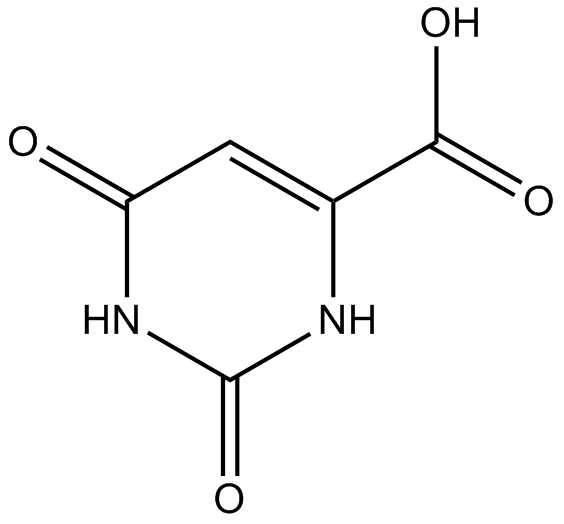Orotic acid |
| Catalog No.GC11528 |
Pyrimidinecarboxylic acid
Products are for research use only. Not for human use. We do not sell to patients.

Cas No.: 65-86-1
Sample solution is provided at 25 µL, 10mM.
Orotic acid (OA) is an intermediate in pyrimidine metabolism.IC50 Value: Target: Nucleoside antimetabolite/analogin vitro: OA increases cell proliferation and decreases apoptosis in serum-starved SK-Hep1 hepatocellular carcinoma cells, which may ascribe to the inhibition of AMP-activated protein kinase (AMPK) phosphorylation and thus activation of mammalian target of rapamycin complex 1 (mTORC1) [1].in vivo: male Fischer 344 rats (130-150 g) to two-thirds PH in the absence or in the presence of OA (a 300-mg tablet of OA methyl ester implanted intraperitoneally at the time of two-thirds PH). treatment with OA resulted in a near-100% inhibition of RNR induced by two-thirds PH in rat liver, as monitored by enzyme activity and protein level [2]. The increases of hepatic OA and betaine levels in OA feeding rats was also found when compared to the normal rats [3]. Feeding 1% OA with diet decreased the phosphorylation of AMPK and increased the maturation of SREBP-1 and the expression of SREBP-responsive genes in the rat liver. OA-induced lipid accumulation was also completely inhibited by rapamycin. Mouse hepatocytes and mice were resistant to OA-induced lipogenesis because of little if any response in AMPK and downstream effectors [4].
References:
[1]. Jung, E.J., K.Y. Lee, and B.H. Lee, Proliferating effect of orotic acid through mTORC1 activation mediated by negative regulation of AMPK in SK-Hep1 hepatocellular carcinoma cells. J Toxicol Sci, 2012. 37(4): p. 813-21.
[2]. Manjeshwar, S., et al., The regulation of ribonucleoside diphosphate reductase by the tumor promoter orotic acid in normal rat liver in vivo. Mol Carcinog, 1999. 24(3): p. 188-96.
[3]. Cha, J.Y., et al., Effect of betaine on the hepatic damage from orotic acid-induced fatty liver development in rats. J Enzyme Inhib Med Chem, 2011.
[4]. Jung, E.J., et al., Role of the AMPK/SREBP-1 pathway in the development of orotic acid-induced fatty liver. J Lipid Res, 2011. 52(9): p. 1617-25.
| Cas No. | 65-86-1 | SDF | |
| Chemical Name | 2,4-dioxo-1H-pyrimidine-6-carboxylic acid | ||
| Canonical SMILES | C1=C(NC(=O)NC1=O)C(=O)O | ||
| Formula | C5H4N2O4 | M.Wt | 156.1 |
| Solubility | ≥ 15.6mg/mL in DMSO with gentle warming | Storage | Store at -20°C |
| General tips | Please select the appropriate solvent to prepare the stock solution according to the
solubility of the product in different solvents; once the solution is prepared, please store it in
separate packages to avoid product failure caused by repeated freezing and thawing.Storage method
and period of the stock solution: When stored at -80°C, please use it within 6 months; when stored
at -20°C, please use it within 1 month. To increase solubility, heat the tube to 37°C and then oscillate in an ultrasonic bath for some time. |
||
| Shipping Condition | Evaluation sample solution: shipped with blue ice. All other sizes available: with RT, or with Blue Ice upon request. | ||
| Prepare stock solution | |||

|
1 mg | 5 mg | 10 mg |
| 1 mM | 6.4061 mL | 32.0307 mL | 64.0615 mL |
| 5 mM | 1.2812 mL | 6.4061 mL | 12.8123 mL |
| 10 mM | 0.6406 mL | 3.2031 mL | 6.4061 mL |
Step 1: Enter information below (Recommended: An additional animal making an allowance for loss during the experiment)
 g
g
 μL
μL

Step 2: Enter the in vivo formulation (This is only the calculator, not formulation. Please contact us first if there is no in vivo formulation at the solubility Section.)
Calculation results:
Working concentration: mg/ml;
Method for preparing DMSO master liquid: mg drug pre-dissolved in μL DMSO ( Master liquid concentration mg/mL, Please contact us first if the concentration exceeds the DMSO solubility of the batch of drug. )
Method for preparing in vivo formulation: Take μL DMSO master liquid, next addμL PEG300, mix and clarify, next addμL Tween 80, mix and clarify, next add μL ddH2O, mix and clarify.
Method for preparing in vivo formulation: Take μL DMSO master liquid, next add μL Corn oil, mix and clarify.
Note: 1. Please make sure the liquid is clear before adding the next solvent.
2. Be sure to add the solvent(s) in order. You must ensure that the solution obtained, in the previous addition, is a clear solution before proceeding to add the next solvent. Physical methods such as vortex, ultrasound or hot water bath can be used to aid dissolving.
3. All of the above co-solvents are available for purchase on the GlpBio website.
Quality Control & SDS
- View current batch:
- Purity: >98.00%
- COA (Certificate Of Analysis)
- SDS (Safety Data Sheet)
- Datasheet
Average Rating: 5 (Based on Reviews and 28 reference(s) in Google Scholar.)
GLPBIO products are for RESEARCH USE ONLY. Please make sure your review or question is research based.
Required fields are marked with *



















